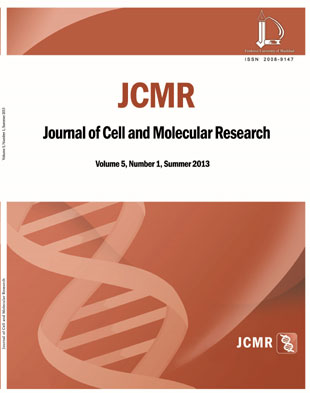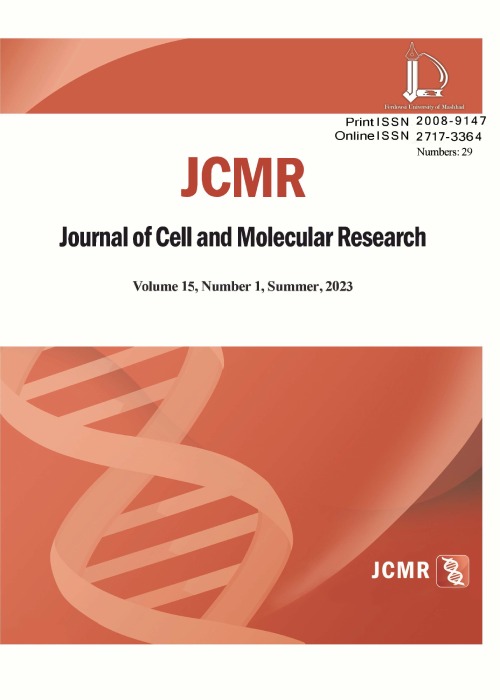فهرست مطالب

Journal of Cell and Molecular Research
Volume:5 Issue: 1, Summer and Autumn 2013
- تاریخ انتشار: 1392/05/05
- تعداد عناوین: 7
-
-
Page 1Stem cells are the cells having some distinguishing characteristics like longevity, high capacity of self-renewal and differentiation, quiescence and highly error-free proliferation. Almost all stem cells have the potential of lineage reprogramming, i.e. inter-conversion of cell lineages. They also have the potential to differentiate into almost all kinds of cells. These cells have been found in almost every organs of human body. Pool of stem cells found in epidermis is termed as Epidermal Stem Cells. Many researchers around the world have reported different kinds of stem cells in skin, based on their cell surface makers, while they have not categorized these cells chronically. It is worth mentioning here that all kinds of stem cells reported in skin, i.e. keratinocyte stem cells, limbal stem cells, hair follicle and bulge stem cells, SG (sebaceous gland) stem cells, and spinous keratinocytes express specific types of cytokeratin protein (e.g. K1, K3, K5, K10, K12, K14, K15, K19 etc.) on their surfaces. Biologists have defined that almost all of these stem cells share single origin, i.e. Basal Layer of Embryonic Skin. As the embryonic skin passes the developmental stages, the basal layer produces two mother stem cells of skin, keratinocyte stem cells, and so called Limbal Stem Cells (in cornea). Keratinocyte stem cells give rise to the cells expressing Cytokeratin proteins on their surfaces. So, all the cells expressing cytokeratin are tracked back to these stem cells in origin, while undergone natural lineage reprogramming or differentiation. The stem cells in the basal-layer give rise to keratinocyte stem cells which can be found in the basal layer of the adult skin. During the developmental stages, this basal layer, containing keratinocyte stem cells, gives rise to limbal invagination of corneal region, a linage conversion mechanism happens, and the keratinocyte stem cells are naturally reprogramed into the limbal stem cells. In basal layer of the epidermis, the keratinocyte stem cells give rise to bulge, hair follicle, and SG stem cells when placode formation takes place. In future, we need studies to find out which kind of cytokeratin protein is expressed early in these cells. In another word it would be helpful to define the order of cytokeratin expression regarding these lineage developmental processes from embryonic to mature skin and from embryonic basal layer to the formation of cornified epithelial cells.Keywords: Epidermal Stem Cells, Cytokeratins, Keratinocytes
-
Page 3Neospora caninum is an obligate intracellular parasitic protozoa and considered as causal agent of Neosporosis which infect wide variety of hosts. NcGRA7 is an immunodominant antigen recognized by sera from bovines, naturally infected by N. caninum, which is used as a powerful target for recombinant or DNA vaccine preparation against neosporosis. There is no study about identifying the molecular structure of Neospora caninum in Iran, so as first step, current study tried to identify NcGRA7 gene in this parasite in Iran. After extraction of total RNA from N. caninum tachyzoites, cDNA was synthesized and NcGRA7 gene was amplified using cDNA as template. Then the PCR product was cloned into pTZ57R/T vector and transformed into Escherichia coli (DH5α strain), and the resulted recombinant plasmid was submitted for sequencing, followed by bioinformatics analysis. The data obtained from sequencing of native NcGRA7 was recorded in GenBank. The deduced amino acid sequence of NcGRA7 in current study was compared with other N. caninum NcGRA7 sequences and showed some identities and differences. NcGRA7 gene of N. caninum was successfully cloned into the pTZ57R/T vector and recombination was confirmed by sequencing, colony PCR, and enzymatic digestion, making it ready expression of recombinant protein for further studies.Keywords: Neospora caninum, NcGRA7, Cloning, Sequencing
-
Page 13Chromosome number, meiotic behavior, and pollen viability were analyzed in 2 species of genus Solenanthus, S. stamineus (Desf.) Wettst. and S. circinnatus Ledeb, from Iran. This report is the first cytogenetic analysis of these species. All taxa are diploid and possess 2n = 2x = 24 chromosome number, consistent with the proposed base number of x = 12. Although this taxon displayed regular bivalent pairing and chromosome segregation at meiosis, but some abnormalities were observed.Keywords: Boraginaceae, chromosome number, meiotic behavior, pollen viability, Solenanthus
-
Page 17Microbial lipids have a great similarity to the lipids obtained from plants and animals. Triacylglycerol is the storage lipid in most of eukaryotic cells; this characteristic attracts a lot of attention for using these lipid sources in biodiesel production. Accumulation of neutral lipid composed of triacylglycerol and sterylster is an induced response to environmental stresses in many living organisms. In this situation lipid accumulates as intracellular lipid bodies in yeast cells. Production of microbial oil has more cost than plant’s oil. In this case, reducing the cost of this process must be done by optimization of culture conditions to reach higher production yield. In this study the effect of physical parameters on lipid production of two oleaginous yeasts: Yarrowia lipolytica M7 and Candida sp. was investigated. The mentioned parameters were pH range of 4-7; centrifugation rates of 100, 150, 200 rpm; temperature of 15, 25, 35 and 45ºC and times of incubation of 24, 48, 72 and 96 h. Temperature and time of incubation had a significant effect on lipid production by these strains and optimization of them resulted in increased production of lipid from 25% to 34% in Yarrowia lipolytica M7.Keywords: physical parameters, oleaginous yeasts, Yarrowia lipolytica M7
-
Page 24Monoamine oxidase (EC, 1.4.3.4) or amine oxidoreductase catalyzes the oxidative deamination of biogenic amines. Abnormal action of the monoamine oxidase B has been associated with neurological dysfunctions including parkinson´s disorder. Monoamine oxidase B inhibitors divulged that these agents were effective in the therapeutic management of Parkinson''s disease. Understanding the interaction of monoamine oxidase binding site with inhibitors is crucial for the development of pharmaceutical agents. At the molecular docking, the exact prediction of the binding modes between the inhibitors and protein is of central importance in structure-based drug design. In the current study, we examined two classes of monoamine oxidase B inhibitors. We applied Autodock tools 4.2, in order to set up the docking runs and predict the inhibitors binding free energy. The final product of molecular docking was clustered to specify the binding free energy and optimal docking energy conformation that is investigated as the best docked structure. Docking results indicate that the contribution of van der Waals interactions is greater than electrostatic interactions so that, it can be concluded that all of the inhibitors attached to a hydrophobic binding site in monoamine oxidase B. Among the total of molecules tested, it was proved that 2-(2-cycloheptylidenehydrazinyl)-4-(2,4-dichlorophenyl)-1,3-thiazole has the lowest binding free energy and the lowest Van der Waals energy and also the lowest inhibition constant and subsequently the most experimental affinity. As well as, we find out a possible relationship between the estimated results and experimental data. The selective information from this work is crucial for the rational drug design of more potent and selective monoamine oxidase B inhibitors based on the 8-benzyloxycaffeine scaffold.Keywords: monoamine oxidase B inhibitor_Parkinson´s disorder_molecular docking_binding free energy
-
Page 35The fungus Colletotrichum gloeosporioides is the causative agent of anthracnose disease of many tropical, subtropical and temperate fruits, and a microbial source of the anticancer drug, Taxol. Here, we introduce an optimized Agrobacterium tumefaciens-mediated transformation (ATMT) protocol for genetic manipulation of this fungus using hph and gfp-tagged hph genes as selection markers. Results showed that falcate spores can be easily used instead of protoplasts for transformation. Several experimental parameters were shown to affect transformation efficiencies, among which the length of co-cultivation, the ratio of fungal conidia to bacterium during co-cultivation, the kind of membrane during co-cultivation, and the kind of fungal growth medium during transformants selection, showed the highest influences on ATMT frequencies. Results indicated that the optimal ATMT of C. gloeosporioides was achived after 3 days of co-cultivation, at 107 per ml fungal conidia, via the use of Fabriano 808 filter paper and Czapek''s culture medium. Successive subculturing of transformants on selective and non-selective media demonstrated the stable expression of transgens, and subsequent PCR based analyses of transformants revealed the presence (100%) of transferred genes. Flourescence microscopy analyses showed a punctuate pattern for localization of an expressed Gfp-tagged Hph protein inside fungal hyphae. The optimized ATMT protocol generated mutants that showed different phenotypes based on their vegetation and pigmentation. This suggests the possible applicability of this technique for functional genetics studies in C. gloeosporioides, through insertional mutagenesis.Keywords: Colletotrichum gloeosporioides, Agrobacterium tumefaciens, ATMT, Genetic transformation, Insertional mutagenesis
-
Page 42The effect of CoCl2 as an ethylene synthesis inhibitor on changes of protein pattern was investigated in potato (Solanum tuberosum L.) plants cultivar White Desiree. In vitro grown plants were subjected to MS medium containing 0, 5, 10, 15, 20, 30, 40 and 60 mg/l CoCl2 for 4 weeks. Different concentrations of CoCl2 showed significant effect on the total soluble proteins. Among different concentrations of CoCl2, using 20 mg/l CoCl2 was the best concentration to inhibit ethylene formation and induce potato plant growth. Application of CoCl2 in the culture medium changed the total protein as well as SDS-PAGE and Iso-electric Point Electrophoresis (PI) patterns. Protein pattern in potato tuber did not show any detectable changes.Keywords: potato, CoCl2, ethylene, protein pattern


